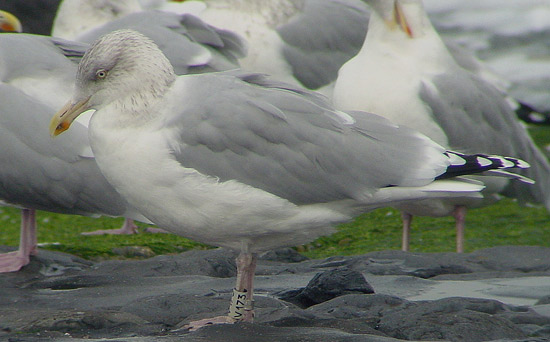 Herring
Gull - Zilvermeeuw (argentatus & argenteus)
Herring
Gull - Zilvermeeuw (argentatus & argenteus)
(last update: 08 december 2003)
Home
Links
to Gull Sites
Gull Taxa
Gull Topography
Grey & Colour Charts
Locations in NW Europe
Summaries of Articles
About ORG
@
Herring Gull V173adult (argentatus), November 17 2002, Westkapelle, the Netherlands (51.33N-03.25E).
This individual is ringed in Denmark: yellow V173 (but faded white) and metal ring Copenhagen 37173. P9 is fully grown and P10 is already as long as P8, PMS: 49. The orbital ring is orange-red, slightly darker than what is commonly found in western argenteus. The sub-terminal black markings on P10 are lacking and the medial band on P10 only covers a limited range of the edge of the inner-web. The inner wing-coverts and upper tertials still have fresh fringes, in much better condition than found in some argenteus, which have these feathers replaced about 4 months ago and show worn fringes by November. The bill in this bird is slightly paler at the base.
From June (often mid-May in France, Belgium and
the Netherlands) to October, a complete moult will bring birds in
so-called "adult winter" plumage. A new set of primaries will
grow during the summer months and by late November, the average argenteus in the Netherlands and northern
France has completely moulted all primaries. At the same time, the wing-covert moult is completed by the end
of the month.
In summer, the head is still largely white,
but by September, most adults develop extensive 'winter streaking', in
sub-adults strongly mottled
brown contrasting with the white breast as in an executioner's hood.
The scapular coverts are plain grey, lacking white crescents. The tertials
show obvious white tips. The iris is yellow. The bill is yellow with a red
gonydeal spot confined to the lower mandible. The orbital ring is
yellow-orange in most argenteus.

